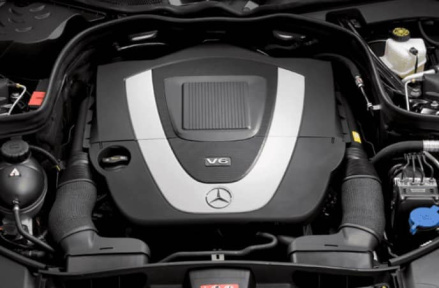
The M272 is a six-cylinder gasoline engine developed by Mercedes-Benz, succeeding the M112. Initially, the engine was offered in the SLK of the R171 series, before it later found its way into numerous other Daimler models. In addition to the variant with manifold injection, a version with direct gasoline injection was also offered under the designation CGI (Charged Gasoline Injection, e.g., 350 CGI).
Mercedes M272 Engine Problems
Problems with the Balance Shaft

The sprocket of the balance shaft can wear prematurely due to material weakness, which usually results in engine damage. Engines with the numbers 272 9 [...] 30 468 993 are affected, or this problem can occur in all engines manufactured until the end of August 2006. A defective sprocket typically announces itself with an illuminated engine control light (Code 1200, 1208) - usually at a mileage between 37,000 to 87,000 miles.
Defective Intake Manifold
The plastic-made shift linkage of the intake manifold can break, usually leading to a noticeable loss of performance. Repair kits are offered to remedy the problem, but only the installation of a new intake manifold module can ensure long-term stability.
Faulty High-Pressure Pump
With CGI, the high-pressure pump may suffer a defect. If this fails, the repair can become quite expensive, as it is not easy to organize and is accordingly highly valued. A faulty high-pressure pump typically announces itself with a sewing machine-like clatter (clearly audible in this YouTube video).
Carbon in the Intake Tract and Valves

Due to direct gasoline injection, the M272 CGI will have to contend with coked injectors and carbon deposits in the intake tract. To at least delay the resulting problems (loss of performance, increased consumption, etc.), it is advisable to use cleaning fuel additives that are added at regular intervals when refueling.
Further Weaknesses of the M272
- NOx Sensor
- Camshaft Adjuster Magnets
- Camshaft Sensors
- Deflection Pulleys
- Serpentine Belt Tensioner
- Engine Mounts
Mercedes M272 Technical Data
| Baureihe | Hubraum | Leistung | Drehmoment |
| M 272 KE 25 | 2.496 cm³ | 150 kW (204 PS) / 6.100 UPM | 245 Nm / 2.900 – 5.500 UPM |
| M 272 KE 30 | 2.996 cm³ | 170 kW (231 PS) / 6.000 UPM | 300 Nm / 2.500 – 5.000 UPM |
| M 272 KE 35 | 3.498 cm³ | 190 kW (258 PS) / 6.000 UPM | 340 Nm / 2.500 – 5.000 UPM |
| M 272 KE 35 | 3.498 cm³ | 200 kW (272 PS) / 6.000 UPM | 350 Nm / 2.400 – 5.000 UPM |
| M 272 KE 35 CGI | 3.498 cm³ | 215 kW (292 PS) / 6.400 UPM | 365 Nm / 3.000 – 5.100 UPM |
| M 272 KE 35 Sportmotor | 3.498 cm³ | 224 kW (305 PS) / 6.500 UPM | 360 Nm / 4.900 UPM |
| M 272 KE 35 Sportmotor | 3.498 cm³ | 232 kW (316 PS) / 6.500 UPM | 360 Nm / 4.900 UPM |
Conclusion
The M272 is a good engine for those who can cope with potentially high maintenance costs. You can read more about complaints related to the M272 engine here. To at least avoid the problem with the sprocket, it is advisable to opt for a Daimler that was manufactured after the end of 2006.
Same articles

Understanding Vehicle Inspection and Verification Services: Why They Matter for Every Driver
GuidesVehicle inspection and verification services are an essential but often overlooked part of keeping roads safe and cars legally compliant. Most people only think about inspections when it’s...
KLIFEX Brand Overview: High-Quality Automotive Repair Kits for Affordable Repairs
GuidesThe automotive aftermarket has long needed solutions that combine reliability, durability, and affordability. Many car enthusiasts and services are looking for a way...
Fast, Reliable Vehicle Emissions & Inspection Services Made Simple
GuidesFast, reliable emissions and inspection services are essential for keeping vehicles road-ready, compliant with environmental regulations, and safe for daily driving. If you’re looking for quick...

